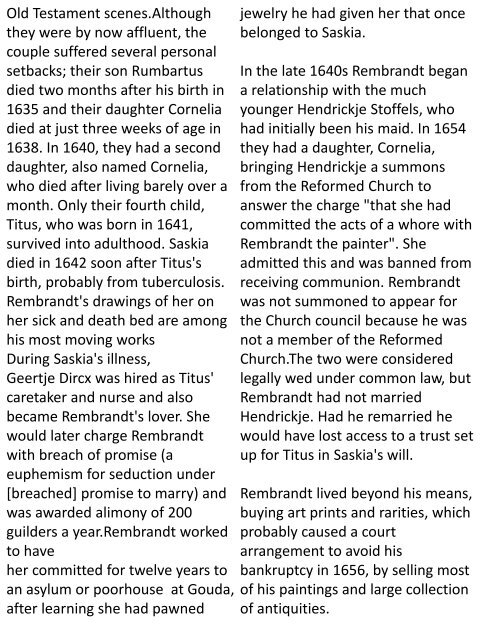Aziz Art January2018
History of art(west and middle east)- contemporary art
History of art(west and middle east)- contemporary art
Create successful ePaper yourself
Turn your PDF publications into a flip-book with our unique Google optimized e-Paper software.
Old Testament scenes.Although<br />
they were by now affluent, the<br />
couple suffered several personal<br />
setbacks; their son Rumbartus<br />
died two months after his birth in<br />
1635 and their daughter Cornelia<br />
died at just three weeks of age in<br />
1638. In 1640, they had a second<br />
daughter, also named Cornelia,<br />
who died after living barely over a<br />
month. Only their fourth child,<br />
Titus, who was born in 1641,<br />
survived into adulthood. Saskia<br />
died in 1642 soon after Titus's<br />
birth, probably from tuberculosis.<br />
Rembrandt's drawings of her on<br />
her sick and death bed are among<br />
his most moving works<br />
During Saskia's illness,<br />
Geertje Dircx was hired as Titus'<br />
caretaker and nurse and also<br />
became Rembrandt's lover. She<br />
would later charge Rembrandt<br />
with breach of promise (a<br />
euphemism for seduction under<br />
[breached] promise to marry) and<br />
was awarded alimony of 200<br />
guilders a year.Rembrandt worked<br />
to have<br />
her committed for twelve years to<br />
an asylum or poorhouse at Gouda,<br />
after learning she had pawned<br />
jewelry he had given her that once<br />
belonged to Saskia.<br />
In the late 1640s Rembrandt began<br />
a relationship with the much<br />
younger Hendrickje Stoffels, who<br />
had initially been his maid. In 1654<br />
they had a daughter, Cornelia,<br />
bringing Hendrickje a summons<br />
from the Reformed Church to<br />
answer the charge "that she had<br />
committed the acts of a whore with<br />
Rembrandt the painter". She<br />
admitted this and was banned from<br />
receiving communion. Rembrandt<br />
was not summoned to appear for<br />
the Church council because he was<br />
not a member of the Reformed<br />
Church.The two were considered<br />
legally wed under common law, but<br />
Rembrandt had not married<br />
Hendrickje. Had he remarried he<br />
would have lost access to a trust set<br />
up for Titus in Saskia's will.<br />
Rembrandt lived beyond his means,<br />
buying art prints and rarities, which<br />
probably caused a court<br />
arrangement to avoid his<br />
bankruptcy in 1656, by selling most<br />
of his paintings and large collection<br />
of antiquities.


















